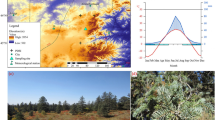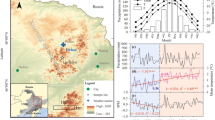Abstract
Fog water inputs can offset seasonal drought in the Mediterranean climate of coastal California and may be critical to the persistence of many endemic plant species. The ability to predict plant species response to potential changes in the fog regime hinges on understanding the ways that fog can impact plant physiological function across life stages. Our study uses a direct metric of water status, namely plant water potential, to understand differential responses of adult versus sapling trees to seasonal drought and fog water inputs. We place these measurements within a water balance framework that incorporates the varying climatic and soil property impacts on water budgets and deficit. We conducted our study at a coastal and an inland site within the largest stand of the regionally endemic bishop pine (Pinus muricata D. Don) on Santa Cruz Island. Our results show conclusively that summer drought negatively affects the water status of sapling more than adult trees and that sapling trees are also more responsive to changes in shallow soil moisture inputs from fog water deposition. Moreover, between the beginning and end of a large, late-season fog drip event, water status increased more for saplings than for adults. Relative to non-foggy conditions, we found that fog water reduces modeled peak water deficit by 80 and 70 % at the inland and coastal sites, respectively. Results from our study inform mechanistically based predictions of how population dynamics of this and other coastal species may be affected by a warmer, drier, and potentially less foggy future.




Similar content being viewed by others
References
Alvarado-Barrientos MS, Holwerda F, Asbjornsen H, Dawson TE, Bruijnzeel LA (2014) Suppression of transpiration due to cloud immersion in a seasonally dry Mexican weeping pine plantation. Agric For Meteorol 186:12–25. doi:10.1016/j.agrformet.2013.11.002
Axelrod DI (1967) Geologic history of the California insular flora. In: Philbrick RN (ed) Proceedings of the symposium on the biology of the California Islands. Santa Barbara Botanical Garden, pp 267–315
Baguskas SA, Peterson SH, Bookhagen B, Still CJ (2014) Evaluating spatial patterns of drought-induced tree mortality in a coastal California pine forest. For Ecol Manage 315:43–53
Berry ZC, Smith WK (2012) Cloud pattern and water relations in Picea rubens and Abies fraseri, southern Appalachian Mountains, USA. Agric For Meteorol 162–163:27–34
Berry ZC, Hughes NM, Smith WK (2014) Cloud immersion: an important water source for spruce and fir saplings in the southern Appalachian Mountains. Oecologia 174:319–326. doi:10.1007/s00442-013-2770-0
Bhaskar R, Ackerly DD (2006) Ecological relevance of minimum seasonal water potentials. Physiol Plant 127:353–359. doi:10.1111/j.1399-3054.2006.00718.x
Burgess SSO, Dawson TE (2004) The contribution of fog to the water status of Sequoia sempervirens (D. Don): foliar uptake and prevention of dehydration. Plant Cell Environ 27:1023–1034. doi:10.1111/j.1365-3040.2004.01207.x
Carbone MS, Still CJ, Ambrose AR, Dawson TE, Williams AP, Boot CM, Schaeffer SM, Schimel JP (2011) Seasonal and episodic moisture controls on plant and microbial contributions to soil respiration. Oecologia 167:265–278. doi:10.1007/s00442-011-1975-3
Carbone MS, Williams AP, Ambrose AR, Boot CM, Bradley ES, Dawson TE, Schaffer SM, Schimel JP, Still CJ (2012) Cloud shading and fog drip influence the metabolism of a coastal pine ecosystem. Glob Chang Biol 19:484–497. doi:10.1111/gcb.12054
Cavender-Bares J, Bazzaz FA (2000) Changes in drought response strategies with ontogeny in Quercus rubra: implications for scaling from seedlings to mature trees. Oecologia 124:8–18
Choat B, Jansen S, Brodribb TJ, Cochard H, Delzon S, Bhaskar R, Bucci SJ, Field TS, Gleason SM, Hacke UE, Jacobsen AL, Lens F, Maherali H, Martinez-Vilalta J, Mayr S, Mencuccini M, Mitchell PJ, Nardini A, Pittermann J, Pratt RB, Sperry JS, Westoby M, Wright IJ, Zanne AE (2012) Global convergence in the vulnerability of forests to drought. Nature 491:752–755. doi:10.1038/nature11688
Corbin JD, Thomsen MA, Dawson TE, D’Antonio CM (2005) Summer water use by California coastal prairie grasses: fog, drought, and community composition. Oecologia 145:511–521. doi:10.1007/s00442-005-0152-y
Dawson TE (1996) Determining water use by trees and forests from isotopic, energy balance and transpiration analysis: the roles of tree size and hydraulic lift. Tree Physiol 16:263–272
Dawson TE (1998) Fog in the California redwood forest: ecosystem inputs and use by plants. Oecologia 117:476–485. doi:10.1007/s004420050683
Dawson TE, Ehleringer JR (1993) Gender-specific physiology, carbon isotope discrimination and habitat distribution of boxelder, Acer negundo. Ecology 74:798–815
Donovan LA, Ehleringer JR (1992) Contrasting patterns among size and life- shrub history classes of a semi-arid shrub. Funct Ecol 6:482–488
Dunne T, Leopold LB (1978) Water in environmental planning. Freeman, New York
Field TS, Dawson TE (1998) Water sources used by Didymopanax pittieri at different life stages in a tropical cloud forest. Ecology 79:1448–1452
Fischer DT, Still CJ (2007) Evaluating patterns of fog water deposition and isotopic composition on the California Channel Islands. Water Resour Res 43:W04420. doi:10.1029/2006WR005124
Fischer DT, Still CJ, Williams AP (2009) Significance of summer fog and overcast for drought stress and ecological functioning of coastal California endemic plant species. J Biogeogr 36:783–799. doi:10.1111/j.1365-2699.2008.02025.x
Goldsmith GR, Matzke NJ, Dawson TE (2013) The incidence and implications of clouds for cloud forest plant water status. Ecol Lett 16:307–314. doi:10.1111/ele.12039
Gotsch SG, Asbjornsen H, Holwerda F, Goldsmith GR, Weintraub AE, Dawson TE (2014) Foggy days and dry nights determine crown-level water balance in a seasonal tropical montane cloud forest. Plant Cell Environ 37:261–272. doi:10.1111/pce.12151
Ingraham NL, Matthews RA (1995) The importance of fog drip water to vegetation: Point Reyes Peninsula, California. J Hydrol 164:269–285. doi:10.1016/0022-1694(94)02538-M
Johnson DL (1977) The late Quaternary climate of coastal California: evidence for an ice age refugium. Quat Res 8:154–179
Johnstone JA, Dawson TE (2010) Climatic context and ecological implications of summer fog decline in the coast redwood region. PNAS 107(10):4533–4538
Johnstone JA, Roden JS, Dawson TE (2013) Oxygen and carbon stable isotopes in coast redwood tree rings respond to spring and summer climate signals. J Geophys Res Biogeosci 118:1438–1450. doi:10.1002/jgrg.20111
Kolb TE, Stone JE (2000) Differences in leaf gas exchange and water status among species and tree sizes in an Arizona pine-oak forest. Tree Physiol 20:1–12
Lambers H, Chapin FS, Pons TL (2008) Plant physiological ecology, 2nd edn. Springer, New York. doi:10.1007/978-0-387-78341-3
Limm EB, Dawson TE (2010) Polystichum munitum (Dryopteridaceae) varies geographically in its capacity to absorb fog water by foliar uptake within the redwood forest ecosystem. Am J Bot 97:1121–1128. doi:10.3732/ajb.1000081
Limm EB, Simonin KA, Bothman AG, Dawson TE (2009) Foliar water uptake: a common water acquisition strategy for plants of the redwood forest. Oecologia 161:449–459. doi:10.1007/s00442-009-1400-3
Mahall BE, Tyler CM, Cole SE, Mata C (2009) A comparative study of oak (Quercus, Fagaceae) seedling physiology during summer drought in southern California. Am J Bot 96:751–761. doi:10.3732/ajb.0800247
Meinzer FC, Woodruff DR, Marias DE, McCulloh KA, Sevanto S (2014) Dynamics of leaf water status components in co-occurring iso- and anisohydric conifer species. Plant Cell Environ 37:2577–2586. doi:10.1111/pce.12327
Passioura JB (1982) Water in the soil-plant-atmosphere continuum. In: Physiological plant ecology, vol II. Springer, Berlin, pp 5–33
R Development Core Team (2012) R: a language and environment for statistical computing. R Foundation for Statistical Computing, Vienna, Austria. http://www.R-project.org/
Raven PH, Axelrod DI (1978) Origin and relationships of the California flora. University of California Press, Berkeley
Ritter A, Regalado CM, Aschan G (2009) Fog reduces transpiration in tree species of the Canarian relict heath-laurel cloud forest (Garajonay National Park, Spain). Tree Physiol 29:517–528. doi:10.1093/treephys/tpn043
Scholl M, Eugster W, Burkard R (2010) Understanding the role of fog in forest hydrology: stable isotopes as tools for determining input and partitioning of cloud water in montane forests. Hydrol Process 25:353–366. doi:10.1002/hyp.7762
Simonin KA, Santiago LS, Dawson TE (2009) Fog interception by Sequoia sempervirens (D. Don) crowns decouples physiology from soil water deficit. Plant Cell Environ 32:882–892. doi:10.1111/j.1365-3040.2009.01967.x
Snyder RL, Eching S (2004) Landscape Irrigation Management Program—IS005 Quick Answer. University of California, Davis
Stephenson NL (1998) Actual evapotranspiration and deficit: biologically meaningful correlates of vegetation distribution across spatial scales. J Biogeogr 25:855–870
Thornthwaite CW, Mather JR (1955) The water balance. Laboratory of Climatology, Centerton
Thornthwaite CW, Mather JR (1957) Instructions and tables for computing potential evapotranspiration and the water balance. Laboratory of Climatology, Centerton
United States Department of Agriculture Forest Service (2014) Forest inventory and analysis national core field guide, volume I. Field data collection procedures for phase 2 plots. Arlington
US Department of Agriculture, Natural Resources Conservation Service (2007) Soil survey of Channel Islands National Park, California. Available at http://soils.usda.gov/survey/printed_surveys/. Accessed 22 October 2012
Vasey MC, Loik ME, Parker VT (2012) Influence of summer marine fog and low cloud stratus on water relations of evergreen woody shrubs (Arctostaphylos: Ericaceae) in the chaparral of central California. Oecologia 170(2):325–337
Walter HS, Taha LA (1999) Regeneration of bishop pine (Pinus muricata) in the absence and presence of fire: a case study from Santa Cruz Island, California. In: Proceedings of the Fifth California Islands Symposium
Williams AP (2006) Teasing foggy memories out of pines on the California Channel Islands using tree-ring width and stable isotope approaches. Masters thesis, Department of Geography, University of California, Santa Barbara
Williams AP, Still CJ, Fischer DT, Leavitt SW (2008) The influence of summertime fog and overcast clouds on the growth of a coastal Californian pine: a tree-ring study. Oecologia 156:601–611. doi:10.1007/s00442-008-1025-y
Acknowledgments
This project was supported through a grant from the Kearney Foundation for Soil Science to C. J. S. and J. Y. K., a UC-Natural Reserve System Mildred E. Mathias graduate student research grant to S. A. B., an instrumentation grant from Decagon Devices to S. A. B., and a grant from the Save The Redwoods League to C. J. S. and S. A. B. Mariah Carbone provided helpful guidance in the field. We thank A. Park Williams for assisting with micrometeorological data acquisition in the field. We thank Lyndal Laughrin and Brian Guerrero for logistical support at the UC-Natural Reserve System on SCI. Jared Nohra and Sabrina Wuu provided excellent undergraduate field and laboratory assistance.
Author contribution statement
S. A. B., C. J. S., J. Y. K., and C. M. D. conceived and designed the study. S. A. B. conducted field and laboratory work, analyzed data, and wrote the manuscript with input and support from C. J. S. and J. Y. K.; D. T. F. contributed to parameterizing the water balance model, interpreting the results, and writing related sections of the manuscript. All authors edited the manuscript.
Author information
Authors and Affiliations
Corresponding author
Additional information
Communicated by Miquel Gonzalez-Meler.
Electronic supplementary material
Below is the link to the electronic supplementary material.
Rights and permissions
About this article
Cite this article
Baguskas, S.A., Still, C.J., Fischer, D.T. et al. Coastal fog during summer drought improves the water status of sapling trees more than adult trees in a California pine forest. Oecologia 181, 137–148 (2016). https://doi.org/10.1007/s00442-016-3556-y
Received:
Accepted:
Published:
Issue Date:
DOI: https://doi.org/10.1007/s00442-016-3556-y




